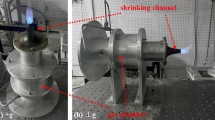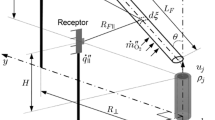Abstract
Outdoor gas pipeline leakage often results in inclined jet fires, often causes the domino incidents in industry and greatly threatens process safety and environment. In practical conditions, the presence of ambient wind and the behavior of gas leakage flame will become more complex and threatening. Massive attentions have been paid on gas leakage jet fire just oriented in vertical or horizontal directions, especially flame morphological scale characteristics. However, few studies have been conducted about the behavior of flames with different upward inclined angles. In this paper, the flame trajectory lengths of different upward inclined angles (0 ~ 90°) were studied with the combined effect of crossflow. Experiments are performed with 3 mm circular nozzle. Propane is used as the fuel in this study and the crosswind speed vary between 0 and 3.48 m s−1. A digital video camera is used to record the flame morphology. The experimental results display that the flame trajectory length increases with increasing inclined angle at low crosswind speeds (u∞ < 0.5 m s−1). As the crosswind speed increases, the flame length decreases with increasing inclined angle. Besides, for small inclination angle (0 ~ 45°) jet fire, the flame trajectory length increases with the increase in the crosswind speed, while in the case of flame inclination angle range of 45 ~ 90°, the flame trajectory length decreases with the increase in the crosswind speed. Then correlation models are developed to predict the flame horizontal length and vertical heights of upward inclined jet fires. And by observing the flame morphology, a mathematical analysis model based on circular approximation is established to predict the flame trajectory length of inclined buoyant jet fire in crosswind, which is useful in process industry. The present model is suitable to correlate all the data in this work, as well as those from previous works.











Similar content being viewed by others
Abbreviations
- \(c_{\text p}\) :
-
Specific heat of air (J kg−1 K−1)
- \(C\) :
-
Fitted coefficient
- \(d\) :
-
Nozzle diameter (m)
- \(Fr_{\infty }\) :
-
Air Froude number
- \(Fr^{*}\) :
-
Modified Froude number
- \(g\) :
-
Acceleration of gravity (m s−2)
- \(l\) :
-
Radius of the circumference (m)
- \(L_{\text f}\) :
-
Flame trajectory line length (m)
- \(L_{\text x}\) :
-
Flame horizontal projection distance (m)
- \(L_{\text y}\) :
-
Flame vertical height (m)
- \(Q^{*}\) :
-
Dimensionless heat release rate
- \(Q^{*}_{\text{mod}}\) :
-
Modified the dimensionless heat release rate
- \(R\) :
-
Momentum ratio of fuel jet to crossflow
- \(T_{\text f}\) :
-
Flame temperature (K)
- \(T_{\infty }\) :
-
Ambient temperature (K)
- \(u_{\text j}\) :
-
Fuel velocity at the nozzle (m s−1)
- \(u_{\infty }\) :
-
Crossair velocity (m s−1)
- \(u_{\text t}\) :
-
Initial velocity of the flame (m s−1)
- \(\theta_{0}\) :
-
Inclination angle relative to the horizontal
- \(\beta\) :
-
Coefficient of thermal expansion of water
- \(\rho_{\text j}\) :
-
Fuel density (kg m−3)
- \(\rho_{\infty }\) :
-
Air density (kg m−3)
- \(\alpha\) :
-
The half of the central angle
- \(\varphi\) :
-
The arc cotangent of \(L_{y}\) and \(L_{x}\)
- \(\phi\) :
-
The angle between \(u_{t}\) and \(u_{\infty }\)
- \(\lambda\) :
-
Parameter defined in Eq. (11)
- \(\sigma\) :
-
Parameter defined in Eq. (16)
References
Cozzani V, Spadoni G, Reniers G. Approaches to domino effect prevention and mitigation. Domino Eff Process Ind [Internet]. Elsevier; 2013 [cited 2021 Oct 21]. p. 176–88.
Reniers G, Dullaert W, Karel S. Domino effects within a chemical cluster: a game-theoretical modeling approach by using Nash-equilibrium. J Hazard Mater. 2009;167:289–93.
Cozzani V, Gubinelli G, Salzano E. Escalation thresholds in the assessment of domino accidental events. J Hazard Mater. 2006;129:1–21.
Oliveira FRL, Doubek G, Vianna SSV. On the behaviour of the temperature field around pool fires in controlled experiment and numerical modelling. Process Saf Environ Prot. 2019;123:358–69.
Heskestad G. Turbulent jet diffusion flames: consolidation of flame height data. Combust Flame. 1999;118:51–60.
Liu SX, Hu LH. An experimental study on flame envelope morphologic characteristics of downward-orientated buoyant turbulent jet fires. Proc Combust Inst. 2019;37:3935–42.
Mashhadimoslem H, Ghaemi A, Behroozi AH, Palacios A. A new simplified calculation model of geometric thermal features of a vertical propane jet fire based on experimental and computational studies. Process Saf Environ Prot. 2020;135:301–14.
Mogi T, Shiina H, Wada Y, Dobashi R. Experimental study on the hazards of the jet diffusion flame of liquefied dimethyl ether. Fuel. 2011;90:2508–13.
Palacios A, Casal J. Assessment of the shape of vertical jet fires. Fuel. 2011;90:824–33.
Smith T, Periasamy C, Baird B, Gollahalli SR. Trajectory and characteristics of buoyancy and momentum dominated horizontal jet flames from circular and elliptic burners. J Energy Resour Technol. 2006;128:300–10.
Wang C, Ding L, Wan HX, Ji J, Huang YL. Experimental study of flame morphology and size model of a horizontal jet flame impinging a wall. Process Saf Environ Prot. 2021;147:1009–17.
Zhou KB, Nie X, Wang C, Wang YD, Niu HC. Jet fires involving releases of gas and solid particle. Process Saf Environ Prot. 2021. https://doi.org/10.1016/j.psep.2021.10.012.
Zhou KB, Wang YZ, Zhang L, Wu YD, Nie X, Jiang JC. Effect of nozzle exit shape on the geometrical features of horizontal turbulent jet flame. Fuel. 2020;260:116356.
Liu Q, Tao CF, Wang P, Meng S, Liu XP, He PX. The flame height of rectangular pool fires bounded by a sidewall with different distances and aspect ratios. J Therm Anal Calorim. 2019;138:1415–22.
Liu JH, Chen MY, Lin X, Yuen R, Wang J. Impacts of ceiling height on the combustion behaviors of pool fires beneath a ceiling. J Therm Anal Calorim. 2016;126:881–9.
Lv J, Zhang XL, Liu SX, Lu HY, Ma YX, Hu LH. Flame morphology of horizontal jets under sub-atmospheric pressures: Experiment, dimensional analysis and an integral model. Fuel. 2022;307:121891.
Pantokratoras A. Horizontal penetration of inclined thermal buoyant water jets. Int Commun Heat Mass Transf. 1998;25:561–9.
Tao CF, Shen Y, Zong RW. Experimental determination of flame length of buoyancy-controlled turbulent jet diffusion flames from inclined nozzles. Appl Therm Eng. 2016;93:884–7.
Liu JH, Wang JH, Chen MY. Estimating the trajectory length of buoyant turbulent jet flames issuing from a downward sloping nozzle. Process Saf Environ Prot. 2019;132:153–9.
Wang ZR, Jiang KW, Zhao K, Guo PK. Macroscopic characteristics and prediction model of horizontal extension length for syngas jet flame under inclined conditions. Int J Hydrog Energy. 2021;46:23091–9.
Liu SX, Delichatsios MA, Hu LH. Flame profile parameters of horizontal turbulent jets: Experiments, similarity analysis and an integral model. Combust Flame. 2019;207:1–9.
Liu JH, Zhang XC, Xie QM. Flame geometrical characteristics of downward sloping buoyant turbulent jet fires. Fuel. 2019;257:116112.
Tao CF, Qian YJ, Tang F, Wang Q. Experimental investigations on temperature profile and air entrainment of buoyancy-controlled jet flame from inclined nozzle bounded the wall. Appl Therm Eng. 2017;111:510–5.
Gao W, Liu NA, Yan J, Xie XD, Zhang LH. Flame trajectory of a non-vertical turbulent buoyant jet flame. Appl Energy Combust Sci. 2021;11:100039.
Hu LH. A review of physics and correlations of pool fire behaviour in wind and future challenges. Fire Saf J. 2017;91:41–55.
Hu LH, Liu SX, Wu L. Flame radiation feedback to fuel surface in medium ethanol and heptane pool fires with cross air flow. Combust Flame. 2013;160:295–306.
Liu CC, Huang LY, Deng TD, Zhou SS, Liu XL, Deng J, et al. On the influence of nozzle geometry on jet diffusion flames under cross-wind. Fuel. 2020;263:116549.
Bandaru RV, Turns SR. Turbulent jet flames in a crossflow: effects of some jet, crossflow, and pilot-flame parameters on emissions. Combust Flame. 2000;121:137–51.
Huang RF, Kimilu RK, Hsu CM. Effects of jet pulsation intensity on a wake-stabilized non-premixed jet flame in crossflow. Exp Therm Fluid Sci. 2016;78:153–66.
Lowesmith BJ, Hankinson G. Large scale experiments to study fires following the rupture of high pressure pipelines conveying natural gas and natural gas/hydrogen mixtures. Process Saf Environ Prot. 2013;91:101–11.
Chen L, Tang F. Experimental study on the longitudinal temperature decay beneath ceiling in ventilated tunnel fires. J Therm Anal Calorim. 2020;139:3179–84.
Fan CG, Yang J, Li MH. A theoretical and experimental study of flame length under a tunnel ceiling. J Therm Anal Calorim. 2017;128:1143–9.
Kalghatgi GT. The visible shape and size of a turbulent hydrocarbon jet diffusion flame in a cross-wind. Combust Flame. 1983;52:91–106.
Kostiuk LW, Mejeski AJ, Poudenx P, Johnson MR, Wilson DJ. Scaling of wake-stabilized jet diffusion flames in a transverse air stream. Proc Combust Inst. 2000;28:553–9.
Majeski AJ, Wilson DJ, Kostiuk LW. Predicting the length of low-momentum jet diffusion flame in crossflow. Combust Sci Technol. 2004;176:2001–25.
Wang JW, Fang J, Lin SB, Guan JF, Zhang YM, Wang JJ. Tilt angle of turbulent jet diffusion flame in crossflow and a global correlation with momentum flux ratio. Proc Combust Inst. 2017;36:2979–86.
Wang JW, Fang J, Guan JF, Zhao LY, Lin SB, Shah HR, et al. Radiative fraction and flame length of propane jet diffusion flames in a crossflow. Combust Explos Shock Waves. 2020;56:375–82.
Mosiria DB, Huang RF, Hsu CM. Characteristics of backward-inclined non-premixed jet flames in crossflow. Exp Therm Fluid Sci. 2018;98:429–44.
Lu HY, Delichatsios MA, Li X, Liu SX, Lv J, Hu LH. Flame geometry of downward buoyant turbulent jet fires under cross flows: experiments, dimensional analysis and an integral model. Proc Combust Inst. 2021;38:4917–25.
Tang F, He Q, Sun XP, Jiang L, Hu P, Hu LH. Experimental study of carriage fire in a tunnel: evolution of flame geometry characteristics under relative strong crosswinds. Proc Combust Inst. 2021;38:4963–70.
Hu LH, Lu KH, Delichatsios M, He LH, Tang F. An experimental investigation and statistical characterization of intermittent flame ejecting behavior of enclosure fires with an opening. Combust Flame. 2012;159:1178–84.
Deng L, Tang F, Wang XK. Uncontrollable combustion characteristics of energy storage oil pool: Modelling of mass loss rate and flame merging time of annular pools. Energy. 2021;224:120181.
Delichatsios MA. Transition from momentum to buoyancy-controlled turbulent jet diffusion flames and flame height relationships. Combust Flame. 1993;92:349–64.
Zhang XC, Xu WH, Hu LH, Liu XZ, Zhang XL, Xu WB. A new mathematical method for quantifying trajectory of buoyant line-source gaseous fuel jet diffusion flames in cross air flows. Fuel. 2016;177:107–12.
Wang Q, Hu LH, Zhang XZ, Zhang XL, Lu SX, Ding H. Turbulent jet diffusion flame length evolution with cross flows in a sub-pressure atmosphere. Energy Convers Manag. 2015;106:703–8.
Acknowledgements
This work was supported jointly by the National Natural Science Foundation of China (NSFC) 51976051 and 51606057.
Author information
Authors and Affiliations
Contributions
Qiang Wang was involved in conceptualization, resources, writing, reviewing and editing, supervision, project administration and funding acquisition. Aquan Lu was responsible for conceptualization, methodology, investigation, formal analysis, data curation, writing the original draft, validation and visualization. Le Chang took part in investigation, writing, reviewing and editing, visualization, and validation. Ben Wang participated in writing, reviewing and editing, visualization and validation.
Corresponding author
Additional information
Publisher's Note
Springer Nature remains neutral with regard to jurisdictional claims in published maps and institutional affiliations.
Rights and permissions
About this article
Cite this article
Wang, Q., Lu, A., Chang, L. et al. A new mathematical method for quantifying flame trajectory length of inclined buoyant jet fires in crosswind. J Therm Anal Calorim 147, 11363–11371 (2022). https://doi.org/10.1007/s10973-022-11348-x
Received:
Accepted:
Published:
Issue Date:
DOI: https://doi.org/10.1007/s10973-022-11348-x




